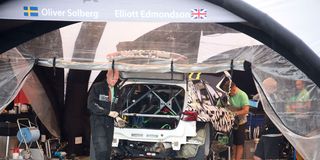Premium
Why your jalopy cannot compete in the Safari Rally

Oliver Solberg's Skoda undergoing assembling at the Naivasha WRC Service Park on March 25, 2024.
What you need to know:
- According to Musa Locho, Chief Scrutineer for WRC 2024, rally cars are divided into different classes and categories
- Despite their impressive speed, rally cars are restricted to a maximum speed of 190 kilometres per hour for safety reasons
- With the Safari Rally returning to its more traditional Easter date during the rainy season, he says that drivers have the freedom to fit their cars with snorkel devices
Easter weekend is here and so is the 2024 World Safari Rally Championship Safari Rally in Naivasha, Nakuru County.
And many rally enthusiasts may be wondering why they can't just jump in their normal car or jalopy and join the competition.
Well, the difference between a standard car and a rally car goes beyond appearances.
For starters, rally cars are purpose-built machines, meticulously designed to cope with the rugged terrain and unpredictable weather conditions of rallying.
According to Musa Locho, Chief Scrutineer for WRC 2024, rally cars are divided into different classes and categories.
At the top of the list are Rally 1 cars, which are manufacturer-owned and not available for public purchase. These cars have high specifications and are built with specialised materials to ensure top performance and safety.
"On the other hand, Rally 2 cars are more accessible to the public, with lower specifications and maintenance costs," Locho explained to Nation.Africa.
"Rally 1 specifications are extremely high, making them expensive as they use a special material to cut down on weight and ensure that the tensile strength of most of the components is of very high standards," he says.
Despite their impressive speed, rally cars are restricted to a maximum speed of 190 kilometres per hour for safety reasons.
Safety is paramount in rallying, with strict regulations set by the Fédération Internationale de l'Automobile (FIA).
"As a fan when you see the rally cars when they are on the stage and they are doing a jump of up to four or five meters in the air and it lands and still rally without suspension you must know the car is very special and extremely expensive," Locho explained.
He said the rally cars are not mass-produced, hence their components are not ordinary which makes them expensive. For example, one wheel suspension costs close to Sh1 million and a car requires four spare parts.
“The other components are built to a very high standard specifications using special materials like the brakes, and exhaust considering how much fire it spits from the back. They are not mass production parts, they are specialized parts built with special equipment and special materials," he noted.
For newcomers interested in rallying, he suggests starting with more affordable options such as Rally 5 cars, which offer a good balance of performance and affordability.
These cars are perfect for learning the ropes before moving up to more powerful categories.
With the Safari Rally returning to its more traditional Easter date during the rainy season, he says that drivers have the freedom to fit their cars with snorkel devices, which allow the car to breathe better in the event of a splash.
“The drivers have been given the freedom to use it or leave, every team has their strategy, there are many things they have to put into consideration, there is weight, when you put the snorkel the power slightly reduces because it breathes harder," he noted.
"Do not be discouraged about rallies one and two, in Kenya we have a few rally two and group N cars which are standard modified cars to rally, they are more affordable. New entrants are advised to use Rally five which is less powerful, and more affordable but with good equipment to learn with.”
When it comes to tires, rally cars use specialized competition-only tires mandated by the FIA to maintain fairness. These tires are equipped with NRF ID codes for easy tracking and verification.
During the event, scrutineers are stationed along the routes to ensure that cars adhere to regulations and compete on a level playing field.
Scrutineers before approving a car to participate in the Safari Rally, first check safety to ensure that it is safe for the rally and that the equipment used by drivers is safe and used correctly as per the regulations and appendices of the FIA.
The scrutineers must weigh the car to ensure that it is within the specification of its weight – it should not exceed or even be under the weight. He revealed that people are being penalized for being 50 grams short.
So, while you might not be able to jump into your everyday car for the Safari Rally, there's still plenty of excitement to be had as spectators cheer on the competitors.





